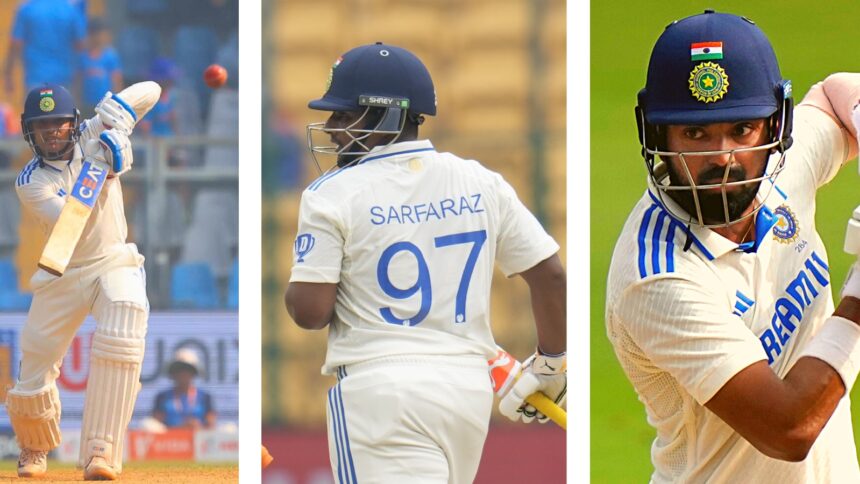The new number four for India in Tests would neither hear the cracking applause when he strides out nor the numbing silence when he retreats to the dressing room. Or to the scale associated with two immediate predecessors, Sachin Tendulkar and . Instead, he could feel the squeezing weight of history and heritage, the burden of 25,151 runs, 51 hundreds, 36 years, the halo and honour, records and responsibility of the inheritance.
The natural heir is , the most promising of the youth brigade, a prospective captain and touted as a future great. He fits the profile—a splendid stroke-maker, stoked in the classical ethos yet with a post-modern outlook, with a game that he could bend to suit diverse conditions, a blossoming superstar, a composed presence, a smiling, handsome face that has begun adorning advertisement hoardings, and non-controversial off the field.
However, him occupying the most sacred post in India’s batting line-up comes at the inevitable expense of a rejig and the consequent headaches.
Gill has just grooved into the one-drop role—an important slot in itself, where the greats Don Bradman, Brian Lara and logged in— especially with a potentially new/makeshift/stopgap opening pair. Now, the team management would have to discover a new number three as well. The options are thin in this facet too. has the required characteristics to blossom as long-term mainstay, but he could be repurposed as an opener. Abhimanyu Easwaran, should he be picked, is still waiting for his Test cap. So is Sai Sudharsan. Rajat Patidar has been tried and tested, but failed, besides nursing an injury.
But if Gill sticks to three, admittedly his favourite spot, he would leave the management fretting to fill up the Kohli space. Rahul’s name springs to mind. He has batted everywhere in the top six, sort of India’s emergency code, barring number five. When Kolhi skipped England’s tour to India last year, he was handed over the keys to the coveted spot. He looked the part and scored 84 and 22 in the first Test before an injury ruled him out for the remaining series, a recurring theme of his start-stop 58-Tests-old career.
Shubman Gill: In the box seat
The most established among India’s batsmen, he has all the tools to succeed at No 4. But the decision could also depend on whether the team management could find a suitable No 3, Gill’s favourite spot and an important one at that.
KL Rahul: The ideal choice
If only India had a settled opening firm, Rahul could have been seamlessly slotted into the spot. He has the experience and knowhow to practise the responsibilities of the role. But the bigger worry is opening, where Rahul’s experience and success in England could see him open.
Karun Nair: The left-field choice
Should he find himself back in the squad, he can stake his claims. He could bat anywhere in the top five, comes with incredible experience and is in the (domestic) form of his life. Familiarity with England conditions would matter too.
Sarfaraz Khan: The outsider
His transition from domestic to Test cricket has been relatively smooth. His Test best has come at number four, and it’s a familiar spot for him in the Mumbai side. All he needs is the trust of the selectors and support staff.
But India need to fill the -shaped hole at the top too, and Rahul could be persuaded to fill in the openers’ shift. The circumstances are different to when Kohli eased into Tendulkar’s shoes. Back then, India could pick any of three—Kohli, Cheteshwar Pujara and —to bat anywhere from three to six. The trio has turned up in most positions as well, and were sufficiently experienced. Not to forget Rohit Sharma knocking on the selectors’ doors too.
Historically, too, India had not sweated over batting inheritances. From Vijay Merchant to Vijay Manjrekar, Sunil Gavaskar to Dilip Vengsarkar and Mohammed Azharuddin, to Virat Kohli, the spiritual lineage passed on unbroken. All teams are illuminated and trapped, in almost equal measure, by their history. But the depth of India’s red-ball batting has been running dry, so much so the once-discarded names are back in the fray.
Like . The failures post his triple hundred in 2016 and the slump with Karnataka had thrust him into wilderness, but a shift to Vidarbha and a consistent run in domestic cricket has rerouted him back to Test reckoning. He has form and county experience behind him, but he would be like a virtual debutant, his last Test coming eight years ago. He was a squad member of India’s 2018 batch to England, but couldn’t impress the management into giving him a chance. Prolific in domestic cricket, his two stints with Northamptonshire yielded considerable profit. In 13 games, he piled 985 runs at 69. Similar numbers in India’s A tour to England could pave his way back to the squad, and could be installed at four.
The selectors are then left with Sarfaraz Khan, , Dhruv Jurel and . The wares of Pant and Jurel are more suited to lower middle-order, where they are endowed with the liberty to trades punches or counterpunch, irrespective of whether the team is wobbling or shining. Jadeja at six or seven offers lower-order stability, besides elongating the batting order. All-rounder Reddy is too callow for the role.
This limits the list to Sarfaraz. He is no stranger to top-four duties. He has transitioned to Test cricket with satisfactory, if not sizzling success. An aggregate of 37.10 in 11 innings with a hundred and three fifties cannot be termed listless by any stretch of imagination. His Test best, a magnificent 150 against New Zealand in , too arrived at four. He could be jumpy at the crease, but has a clarity of approach and purpose to succeed at this level. Worrying, though, is the think tanks’ lack of trust in his batting abroad, as he was largely a passenger in Australia last year.
The deeper the crisis is assessed the surer Gill’s ascent to the number four seems. Not only because there aren’t other suitable alternatives, but also he seems the worthiest man for the role. The move has other benefits too. The line-up would not be top heavy. Experience and talent would be more equitably distributed. Imagine a situation where a top-three of Jaiswal, Rahul and Gill being blown by a new-ball burst, India would be left with an undercooked middle order.
It would take Gill some getting used to, but it’s not just runs and hundreds that await him, but history and heritage too. The mantle could crush him, it could inspire him to cricketing immortality too.








